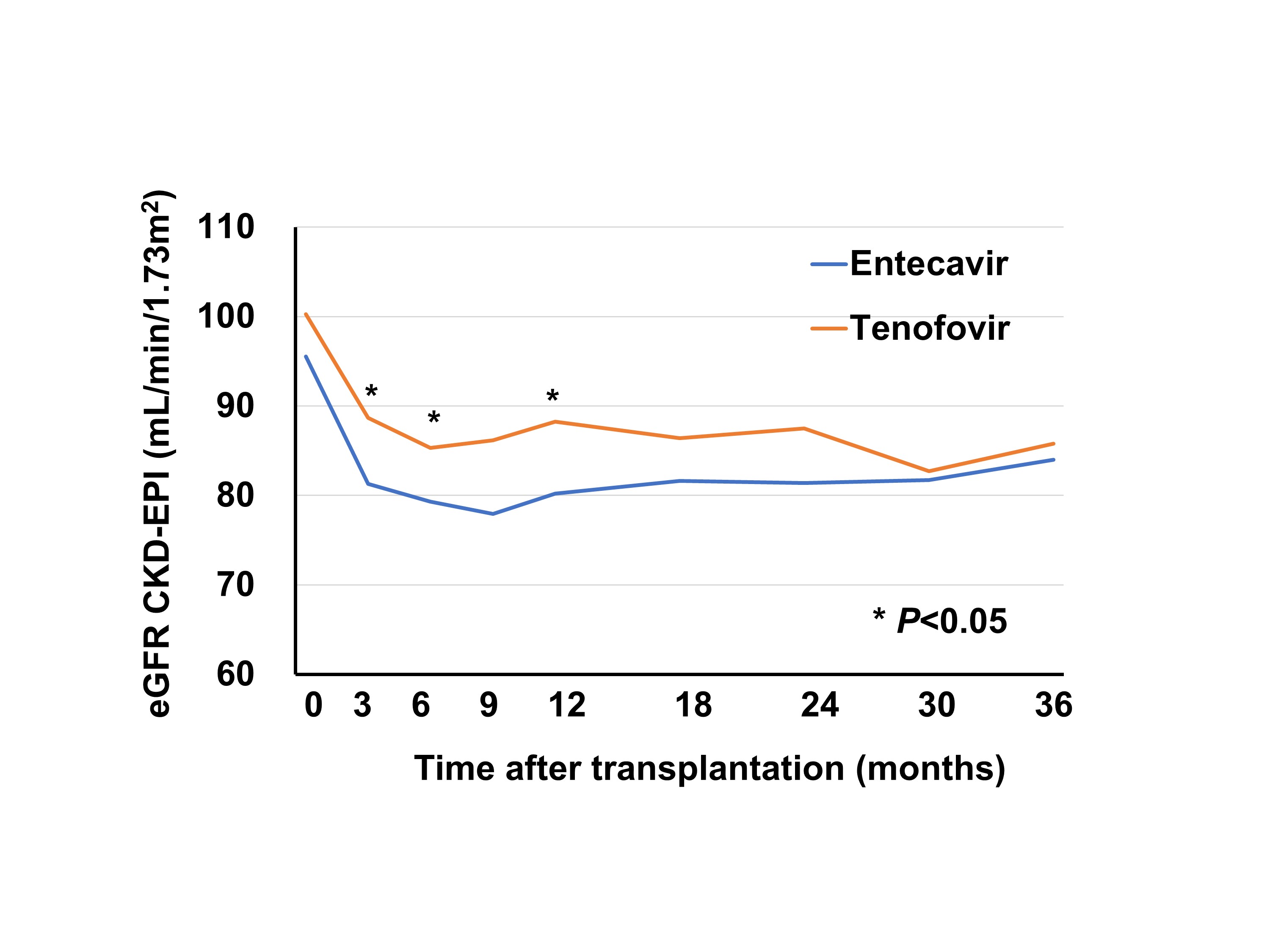Renal Safety Of Entecavir And Tenofovir With Hepatitis B Immunoglobulin In Liver Transplant Patients
1Surgery, Yonsei University College of Medicine, Seoul, Korea, Republic of, 2Internal Medicine, Yonsei University College of Medicine, Seoul, Korea, Republic of
Meeting: 2019 American Transplant Congress
Abstract number: A285
Keywords: Glomerular filtration rate (GFR), Hepatitis B, Liver transplantation, Nephrotoxicity
Session Information
Session Name: Poster Session A: Liver - Kidney Issues in Liver Transplantation
Session Type: Poster Session
Date: Saturday, June 1, 2019
Session Time: 5:30pm-7:30pm
 Presentation Time: 5:30pm-7:30pm
Presentation Time: 5:30pm-7:30pm
Location: Hall C & D
*Purpose: Combination of potent nucleos(t)ide analougues (NAs) and hepatitis B immunoglobulin is recommended after liver transplantation for the prevention of hepatitis B virus (HBV) recurrence. Despite its proven efficacy, renal safety of NAs in liver transplant recipients has not been well defined. We aimed to assess the impact of entecavir and tenofovir on glomerular and tubular function.
*Methods: We analyzed 201 liver transplant patients treated with entecavir (n=122) or tenofovir (n=79) with hepatitis B immunoglobulin between 2012 and 2016. Serum creatinine, phosphorus, and uric acid were measured, and estimated glomerular filtration rate (eGFR) was calculated using the Chronic Kidney Disease Epidemiology Collaboration equation. Proximal tubular dysfunction was defined as the combination of hypophosphatemia (< 2 mg/dL) and hypouricemia (< 2 mg/dL).
*Results: Mean eGFR at start of NAs after liver transplant was 100.8 for entecavir, 102.7 mL/min/1.73 m2 for tenofovir group (P=0.554). Mean eGFR at the last on-treatment visit was 80.0 for entecavir and 82.5 mL/min/1.73 m2 for tenofovir group (P=0.491). During the 28 months of median follow-up, 30 patients experienced decrease of eGFR < 30 mL/min/1.73 m2 (20 [16.4%] of entecavir and 10 [12.7%] of tenofovir group, P=0.468). Serum phosphorus and uric acid in both groups were statistically not significant at start of NAs. A total of 37 patients developed renal tubular dysfunction (11 [9.0%] of entecavir and 26 [32.9%] of tenofovir group, P<0.001). Tenofovir (HR, 5.24; 95% CI, 2.25-12.19; P<0.001), decrease of eGFR < 30 mL/min/1.73 m2 (HR, 4.44; 95% CI, 1.67-11.85; P=0.003), and use of mTOR inhibitor (HR, 2.31; 95% CI, 1.04-5.11; P=0.04) were independent risk factors for proximal tubular dysfunction.
*Conclusions: The effect of tenofovir on glomerular function was comparable to that of entecavir in liver transplant patients. However, tenofovir increased the risk of proximal tubular dysfunction. Longitudinal studies are needed to assess the long-term outcomes.
To cite this abstract in AMA style:
Kim D, Lee J, Kim E, Kim S, Ihn K, Joo D, Huh K, Kim B, Kim M, Kim S, Kim Y, Lee J. Renal Safety Of Entecavir And Tenofovir With Hepatitis B Immunoglobulin In Liver Transplant Patients [abstract]. Am J Transplant. 2019; 19 (suppl 3). https://atcmeetingabstracts.com/abstract/renal-safety-of-entecavir-and-tenofovir-with-hepatitis-b-immunoglobulin-in-liver-transplant-patients/. Accessed December 17, 2025.« Back to 2019 American Transplant Congress

